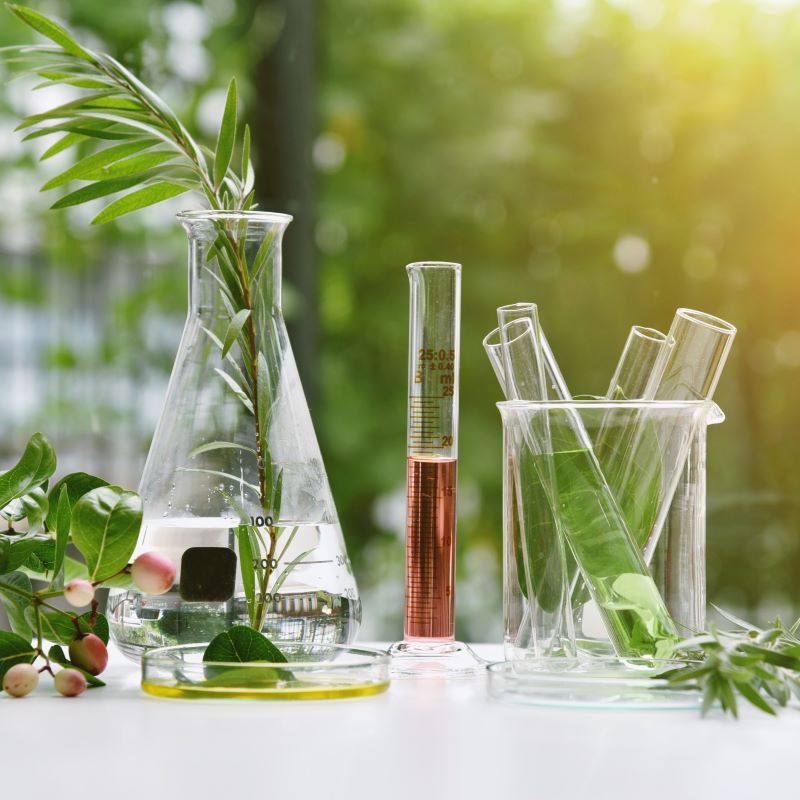Blooming botanicals: Ashland eco-sources chamomile, Givaudan spotlights milk thistle and study supports Orpheus flower

25 Jun 2024 --- With consumer interest in natural ingredients rising, Personal Care Insights spotlights botanical innovations from Givaudan Active Beauty and Ashland plus a study of Orpheus flower’s cosmetic applications. We look at eco-sourcing methods and extracts from milk thistle, indigo, patchouli, mango leaves and chamomile for application to personal care products.
Givaudan’s latest botanical innovations
Giada Maramaldi, global category manager for Botanical Actives at Givaudan, tells us why Silybidiol is a natural and safe alternative to CBD:
“Activating CB2 receptors and protecting the OxInflammation balance, it is an innovative concept in cosmetic science. Silybidiol is extracted from the fruit of the milk thistle and is standardized with the polyphenols typical of milk thistle.”
.jpg) Silybidiol is a natural and safe alternative to CBD and protects the OxInflammation balance.“A few weeks ago, we also introduced Neuroglow, an active ingredient derived from Persicaria tinctoria, indigo. It boosts the natural production of melanin, promotes a healthy tan, counteracts the risks of excessive sun exposure and, like the sun, promotes well-being,” she adds.
Silybidiol is a natural and safe alternative to CBD and protects the OxInflammation balance.“A few weeks ago, we also introduced Neuroglow, an active ingredient derived from Persicaria tinctoria, indigo. It boosts the natural production of melanin, promotes a healthy tan, counteracts the risks of excessive sun exposure and, like the sun, promotes well-being,” she adds.
Maramaldi says Indigo leaves must be processed a few hours after harvesting and can only be done at sunrise and sunset, in the coolest hours of the day, as opposed to standard plant sources typically harvested and dried. The entire supply chain is based in Provence, France.
“On the upcycling theme, we presented Patchoul’Up, an active ingredient obtained from exhausted patchouli leaves after extracting the odorous molecules. Patchoul’Up is obtained by subcritical water extraction, a specific technology that increases the solvent potency of water,” shares Maramaldi. It targets the scalp, provides hydration, rebalancing the microflora and boosts well-being. It has been evaluated using a standardized neuroscientific methodology called mood portraits.
Lastly, Maramaldi touts Mangixyl, derived from mango leaves, for greasy, pro-acne skin. It reduces sebum production and the activity of C. acnes.
“In the research and development of green fractionation, we favor side streams and upcycled supply chains in our pipeline to value waste that still has bioactive molecules,” she adds. “Regarding crops, our agronomists find sustainable solutions for water management, pest control, yield improvement, etc. We have ongoing field audits with certified bodies to ensure we are constantly working to improve sustainability.”
Ashland’s calming chamomile
Justine Cotton, Ashland’s global marketing leader in cosmetic bioactives believes its latest innovation, Perfectyl, is a skin enhancing chamomile extract.
“Perfectyl is developed with our proprietary Zeta Fraction technology, which allows us to obtain a highly pure ingredient that is water-free and solvent-free, natural at 99.3% according to ISO 16128, vegan and readily biodegradable,” she says.
“Inspired by new aesthetic techniques for relaxing facial lines without injections, this revolutionary active is designed to clarify and smooth skin flaws. Perfectyl enhances skin benefits for smooth, clear skin with a powerful activity on pores, hyperpigmentation and imperfections.”
Zeta Fraction for eco-sourcing
Cotton says Ashland’s ESG sustainability strategy includes producing new bioactives with three key pillars: sustainable sourcing, operations and solutions.
 Ashland’s chamomile extract is pure at 99%, has 95 times more flower acids, 40 times more vitamin B5 and seven times more GABA amino acids than classic chamomile extracts.“The Zeta Fraction exemplifies the three pillars of sustainable, innovative technology. It is the only technology that starts processing in the fields with a mobile unit that goes directly to chamomile fields during the blooming season. The Zeta Fraction technology uses only fresh and living chamomile flowers and leaves to reveal a new environmentally friendly extract as a pure patented serum.”
Ashland’s chamomile extract is pure at 99%, has 95 times more flower acids, 40 times more vitamin B5 and seven times more GABA amino acids than classic chamomile extracts.“The Zeta Fraction exemplifies the three pillars of sustainable, innovative technology. It is the only technology that starts processing in the fields with a mobile unit that goes directly to chamomile fields during the blooming season. The Zeta Fraction technology uses only fresh and living chamomile flowers and leaves to reveal a new environmentally friendly extract as a pure patented serum.”
She adds that the technology is clean and sustainable, using “specific fine-tuned electromagnetic waves and physical properties to fractionate plant cells and extract a pure serum fraction (cytosol fraction).”
Cotton says Ashland uses a traceable local supply in Oregon, US, where flowers are hand-picked among local communities and transported by road to limit environmental footprint.
Zeta Fraction is used on the farm without chemicals, and the waste is returned to the ground after it is treated, shares Cotton. “The technology demonstrates an exceptional eco-profile in comparison to classic extraction. Global warming potential is five times lower, ozone depletion potential is ten times lower and primary energy demand is five times lower.”
“Our chamomile extract is pure at 99% and shows an extraordinary composition: 95 times more flower acids, 40 times more vitamin B5, and seven times more GABA amino acids, compared to classic chamomile extract.”
“Generally, a classic solvent extract is represented between 10% and 25% in the final composition, so when a cosmetic formulator uses Perfectyl at 1%, he uses 1% of 99%. The formulation will have more active molecules and more efficacy than 1% of 10% to 25%.”
Quality and purity of botanical ingredient
When examining botanicals’ quality and purity, Maramaldi of Givaudan says: “It starts right at the beginning of the supply chain. How a plant is sourced and where it is cultivated, the time and method of harvesting, and how it is processed before extraction are parameters that must be taken into account.”
“This is the subject of strict quality procedures, so the biomass before being cleared is controlled using an identification pack to identify the species, gender and family of the plant, and its biomarker content. To confirm the authenticity of our plants, we carry out botanical identification using microscopy and microscope, HPTLC and profile to identify metabolites, HPLC fingerprinting and genomic identification using DNA analysis.”
She states that quality procedures and in-process controls are implemented once the biomass’s quality has been confirmed to guarantee process reproducibility, specification compliance and purity in Givuadan’s product.
Meanwhile, Cotton of Ashland tells us the company ensures high quality by using methodologies — like bioinformatics and molecular docking science — to study facets of botanical ingredients.
According to Cotton, Ashland routinely conducts thorough analytical studies and mandatory toxicological tests for cosmetics, including cutaneous and ocular irritation, phototoxicity, genotoxicity and cutaneous sensitivity, ensuring no animal testing to support cruelty-free claims.
The company also performs biodegradation and ecotoxicity studies and has developed an OCDE TG249-validated alternative method to fish testing.
Researchers suggest further studies on M2’s use in creating new therapeutic agents or skin care formulations (Image credit: Cosmetics). She adds that Ashland ensures high purity by ensuring the absence of heavy metals, residual solvents, pesticides, aflatoxins, mycotoxins and allergens. It adheres to new regulations for 81 allergens with independent verification for its entire catalog, including new botanical ingredients.
Orpheus flower for bioactives
A paper in Cosmetics examines the cytotoxic and antiproliferative effects of two herb extracts from Haberlea rhodopensis Friv., also known as Orpheus flower, on cancer cells, with applications in cosmetics.
Traditionally used in folk medicine for its therapeutic properties, the Orpheus flower has gained attention recently due to its bioactive compounds, including myconoside and flavonoids, for potential applications in skin care.
Healing skin conditions
The study compared the effects of two flower extracts, Extract 1 (E1) and Extract 2 (M2), on cancer cells to the reference anticancer drug doxorubicin. Both inhibited cancer cell growth, but M2 with myconoside had better cytotoxic and antiproliferative activities.
Furthermore, M2 showed “significant” cytotoxicity within 24 hours and antiproliferative effects over 48 and 72 hours, particularly against non-cancerous 3T3 cells.
Research suggests its potential applications in skin care formulations for conditions where cell proliferation needs to be regulated, such as psoriasis or eczema.
According to the study, M2 displayed IC50 values (the concentration required to inhibit 50% of cell growth) between 40 and 59 µg/mL, indicating its potential as a natural alternative for skin care products targeting skin conditions.
However, researchers suggest further studies on M2’s use in creating new therapeutic agents or skin care formulations.
By Venya Patel













